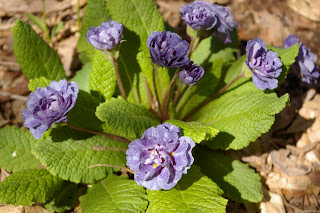 |
| Dictamnus- Gas Plant |
Day 13
I love unusual plants. What I love even more are unusual plants that are long lived perennials and require no fuss- no staking, dividing, spraying, nothing. Add to that excellent, glossy, disease free foliage that looks good from spring until fall and you have a perfect description of Dictamnus, referred to as the gas plant.
What a strange common name! Rumor has it that that when the flower is in bloom, you can hold a lit match next to it and it will pop. I don't know of anyone who has done this successfully but I do know that a shipment of Dictamnus roots was not allowed into the country from Holland after 9/11 because the roots were deemed potential explosives. The leaves, stems, flowers, and roots are full of a very aromatic, strong essential oil that smells a bit like lemons. I can recognize this scent on a warm, humid day if I simply walk near the plants. I am especially on the lookout for my gas plant when weeding in the summer because I am allergic to it! I belong to a small group of people who have a phytotoxic reaction to the oil, causing a deep red mark and a burning sensation on my skin. This takes a few weeks to go away. I was surprised the first time it happened but I had seen the same effect on one of my employees who was allergic to rue so I quickly figured it out. Now I just enjoy this plant and if I need to get near it to weed, I wear long sleeves. I haven't had a problem since.
Why grow a plant that you are allergic to? Good question. I LOVE Dictamnus. It is as permanent in the garden as Baptisia or peonies. It takes up to five years to establish a good sized clump, but then you can just forget about it. It flowers in late May and June, pairing beautifully with irises, peonies, and coral bells. I have seem many people use them as cut flowers, but not me, for obvious reasons.
I am also allergic to Russian sage (Perovskia) and Rhododendrons. With these two plants, I have a coughing fit when working amongst them. That doesn't mean I don't grow Perovskia. It is on of my primary plants for full sun and dry soil, especially where deer are an issue. Luckily, it requires little work on my part. Rhododendrons only make me cough when I climb inside of them to prune them. In June, I often do drastic pruning deep inside the plant to reduce the height and open up the inside to get more light, thus encouraging branching. I also love to clean out all the dead wood in the middle of the plants as it makes them look so architectural. I simply put a bandana over my face when doing this work and that seems to do the trick.
If you spot a Dictamnus plant at the nursery, you will probably be disappointed to find a tiny sprig of a thing for a large price. Because they are hard to propagate and REALLY slow growing, they are expensive. Let's just say they don't fly off the retail benches like other plants. Only people who know what they are and what they can become will get excited to see them as they are pretty rare in the trade. I observed a nice sized plant linger on our benches for one entire growing season. It actually was the biggest plant I had ever seen in a pot and I had admired many gas plants in old, established gardens. Finally, in November, I couldn't stand it any more, took it home, and gave it a place of honor in my garden. Now I have a nice big gas plant to admire, and dance around, from spring until fall.




















